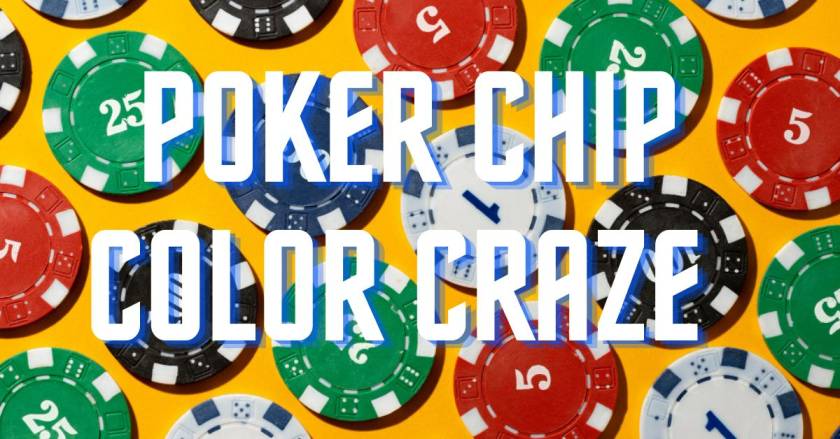Poker Chip Color Craze: The Importance of Poker Chip Color Value
Poker is a fascinating game that combines both luck and strategy. It requires players to make calculated decisions based on the cards they are dealt, while also leaving room for chance to play a role in the outcome. But there’s more to poker than just the cards and the strategies. The game also has a touch of flair and style, and one of the best ways to add some personality to your game is with colorful poker chips.
Did you know that each poker chip color value has a specific value? That’s right, in the world of poker, the color of your chips is just as important as the cards in your hand. This may come as a surprise to some players, but it’s a crucial aspect of the game that can greatly impact the gameplay.
In most casinos and home games, different colored chips represent different values. The standard values are usually white or blue for the lowest denomination, red for a mid-range value, and green for the highest value. However, these values can vary depending on the game and the rules established by the players. Knowing each poker chip color value allows players to better manage their chips and make informed decisions during the game.
In addition to the value, the color of the chips can also add an extra layer of excitement and style to the game. Players can choose chips with their favorite colors or a combination of colors that represents their personality. This not only adds a personal touch to the game but also makes it more visually appealing.
Here in this article, get all you want to know about poker chips including how much are poker chips worth, and how many chips for poker will be enough! Stay tuned.
The Secret Behind the Shades: Understanding Poker Chip Color Value
Have you ever wondered about the worth of a poker chip? It’s more than just a colorful disc – the value of a poker chip is determined by its color and is an essential aspect of the game.
Different Colored Chips Represent Different Values
In most casinos and home games, different colored chips are used to represent different values. The standard values are typically white or blue for the lowest denomination, red for a mid-range value, and green for the highest value. But, it’s essential to note that these values can vary depending on the specific game being played and the rules established by the players.
The Flexibility of Chip Values
For example, in a home game with a low buy-in, the players may agree to use red chips as the lowest denomination and green chips as the highest value. This flexibility in chip values can add an extra level of excitement to the game and create a unique betting experience.
Importance of Managing Chip Values
The value of each chip plays a significant role in the gameplay. Players must carefully manage their chips and make informed decisions based on the value of each chip in their stack. Knowing the value of each chip allows players to make the most of their betting opportunities and better control the outcome of the game.
The Psychology of Chip Values
Moreover, the psychology of chip values can also come into play. For instance, some players may be more conservative with their chips if they have higher denominations, while others may be more willing to take risks if their chips are worth less. The values of the chips can also affect the dynamics of the game, such as when players try to “color up” their lower denomination chips for higher denomination chips to simplify their stacks.
Chip It Up: How Many Chips for Poker? Let’s Count!
When it comes to the number of chips each player should have in a game of poker, the answer is not set in stone. Instead, it depends on various factors such as the buy-in amount and the maximum and minimum bets allowed in the game. Determining the appropriate number of chips for each player is essential for ensuring a smooth and enjoyable game.
A common rule of thumb for determining the number of chips per player is to have about 50 to 100 chips. This amount provides enough chips for betting and raising without having to constantly refill the stacks. Having a sufficient number of chips also allows players to better manage their bets and make informed decisions throughout the game.
However, the exact number of chips needed for each player will vary depending on the specific game being played and the buy-in amount. For example, in a high-stakes game with a high buy-in, players may need a larger number of chips to accommodate the larger bets being made. On the other hand, in a low-stakes game with a low buy-in, a smaller number of chips may be sufficient.
It’s also important to consider the type of game being played and the betting structure. In some games, players may need to make larger bets at certain points in the game, which would require a larger stack of chips. On the other hand, in games with a more relaxed betting structure, a smaller number of chips may be sufficient.
Hence, determining the appropriate number of chips for each player in a game of poker is essential for ensuring a smooth and enjoyable game. A good rule of thumb is to have about 50 to 100 chips per player, but the exact number will vary depending on the buy-in amount, the maximum and minimum bets allowed in the game, and the type of game being played.
The Final Word: The Significance of Poker Chip Color Value
Poker chip color value is a crucial aspect of the game of poker that adds an extra layer of excitement and strategy. Understanding the value of each color and having the appropriate number of chips for poker can greatly impact your gameplay and the decisions you make during the game.
In most casinos and home games, different colored chips represent different values. The standard values are usually white or blue for the lowest denomination, red for a mid-range value, and green for the highest value. However, these values can vary depending on the game and the rules established by the players.
Knowing the value of each color chip allows players to make informed decisions about their bets and the amount of chips they should have in their stack. A good rule of thumb for determining the number of chips per player is to have about 50 to 100 chips. This amount provides enough chips for betting and raising without having to constantly refill the stacks.
At last, poker chip color value adds an extra layer of excitement and strategy to the game of poker. Understanding the value of each color and having the appropriate number of chips is essential for making informed decisions and controlling the outcome of the game. So next time you sit down for a game of poker, take a closer look at those chips in front of you and remember the significance of their color value in the game.


